check engine OLDSMOBILE SILHOUETTE 1995 User Guide
[x] Cancel search | Manufacturer: OLDSMOBILE, Model Year: 1995, Model line: SILHOUETTE, Model: OLDSMOBILE SILHOUETTE 1995Pages: 390, PDF Size: 20.27 MB
Page 240 of 390

3800 V6: Recovery Tank Level
l I I
The coolant level should be at or above the FULL HOT
mark. If it isn’t, you may have a leak in the radiator
hoses, heater hoses, radiator, water pump or somewhere
else in the cooling system.
I NOTICE:
Engine damage from running your engine
without coolant isn’t covered by your warranty.
If there seems to be no leak, with the engine on, check to
see if the electric engine fan is running.
If the engine is
overheating, the fan should be running.
If it isn’t, your
vehicle needs service.
5-18
ProCarManuals.com
Page 264 of 390
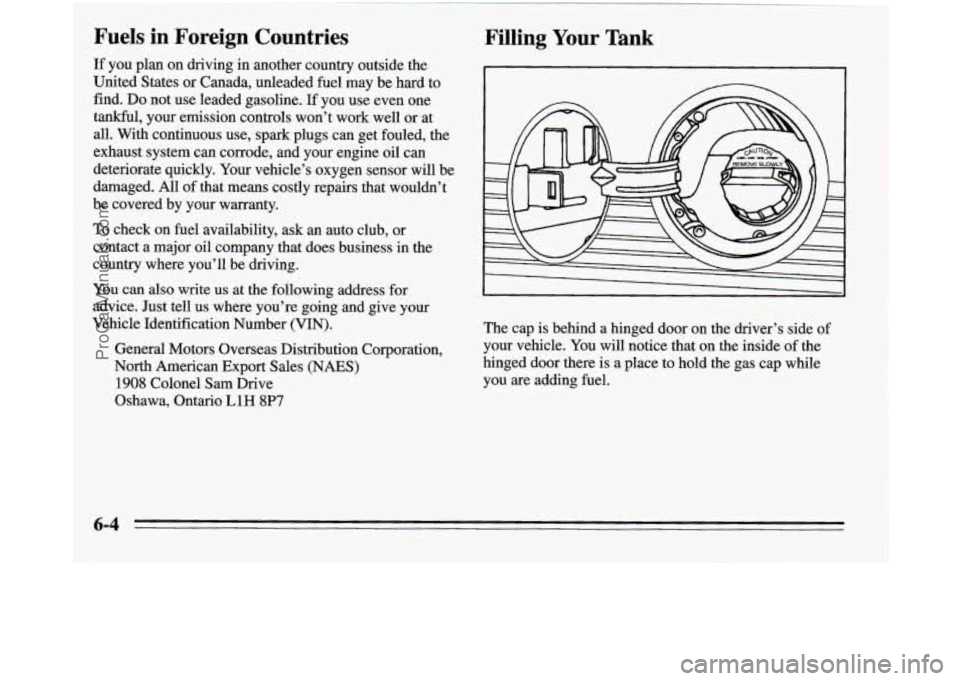
~~~ Fuels in Foreign Countries
If
you plan on driving in another country outside the
United States or Canada, unleaded
fuel may be hard to
find. Do not use leaded gasoline.
If you use even one
tankful, your emission controls won’t work well or at
all. With continuous use, spark plugs can get fouled, the
exhaust system can corrode, and your engine oil can
deteriorate quickly. Your vehicle’s oxygen sensor will be
damaged. All of that means costly repairs that wouldn’t
be covered by your warranty.
To check on fuel availability, ask an auto club, or
contact a major oil company that does business in the
country where you’ll be driving.
You can also write us at the following address for
advice. Just tell us where you’re going and give your
Vehicle Identification Number (VIN).
General Motors Overseas Distribution Corporation,
North American Export Sales (NAES)
1908 Colonel Sam Drive
Oshawa, Ontario
L1H 8P7
Filling Your Tank
The cap is behind a hinged door on the driver’s side of
your vehicle.
You will notice that on the inside of the
hinged door there is a place to hold
the gas cap while
you are adding fuel.
6-4
ProCarManuals.com
Page 271 of 390
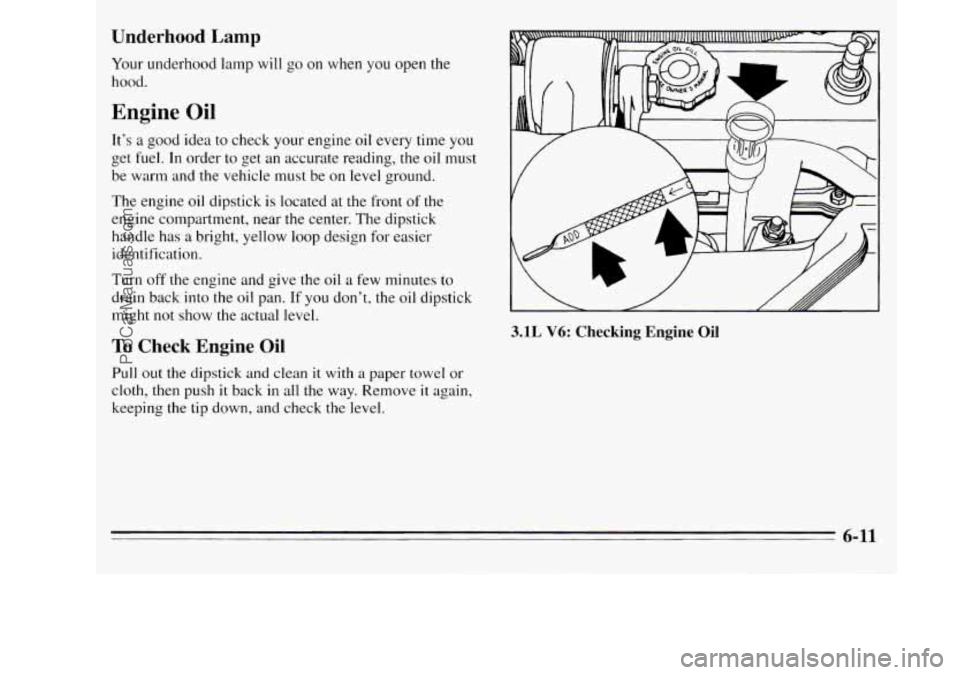
Underhood Lamp
Your underhood lamp will go on when you open the
hood.
Engine Oil
It’s a good idea to check your engine oil every time you
get fuel. In order to get an accurate reading, the oil must
be warm and the vehicle must be on level ground.
The engine oil dipstick is located at the front of the
engine compartment, near the center.
The dipstick
handle has
a bright, yellow loop design for easier
identification.
Turn off
the engine and give the oil a few minutes to
drain back into the
oil pan. If you don’t, the oil dipstick
might not show
the actual level.
To Check Engine Oil
Pull out the dipstick and clean it with a paper towel or
cloth, then push
it back in all the way. Remove it again,
keeping the tip down, and check the level.
I/
I
3.1L V6: Checking Engine Oil
6-11
ProCarManuals.com
Page 279 of 390
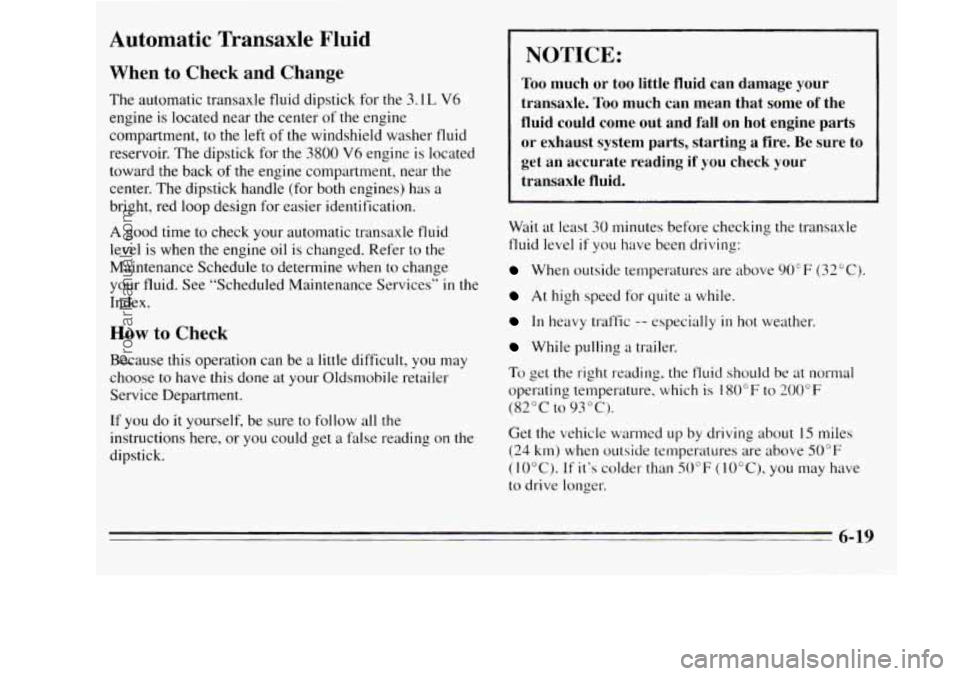
Automatic Transaxle Fluid
When to Check and Change
The automatic transaxle fluid dipstick for the 3.1 L V6
engine is located near the center of the engine
compartment, to the left
of the windshield washer fluid
reservoir. The dipstick for
the 3800 V6 engine is located
toward the back
of the engine Compartment, near the
center. The dipstick handle (for both engines) has
a
bright, red loop design for easier identification.
A good time to check your automatic transaxle fluid
level is when the engine oil is changed. Refer to the
Maintenance Schedule to determine when to change
your fluid. See “Scheduled Maintenance Services”
in the
Index.
How to Check
Because this operation can be a little difficult, you may
choose to have this done at your Oldsmobile retailer
Service Department.
If
you do it yourself, be sure to follow all the
instructions here, or
you could get a false reading on the
dipstick.
NOTICE:
Too much or too little fluid can damage your
transaxle.
Too much can mean that some of the
fluid could come out and fall on hot engine parts
or exhaust system parts, starting a fire. Be sure to
get
an accurate reading if you check your
transaxle fluid.
Wait at least 30 minutes before checking the transaxle
fluid level
if you have been driving:
When outside temperatures are above 90°F (32°C).
At high speed for quite a while.
In heavy traffic -- especially in hot weather.
While pulling a trailer.
To get the right reading, the fluid should be at normal
operating temperature, which is 180°F
to 200°F
(82°C to 93°C).
Get the vehicle warmed up by driving about 15 miles
(24 km) when outside temperatures are above 50°F
(10°C).
If it’s colder than 50°F (lO°C), you may have
to drive longer.
ProCarManuals.com
Page 280 of 390
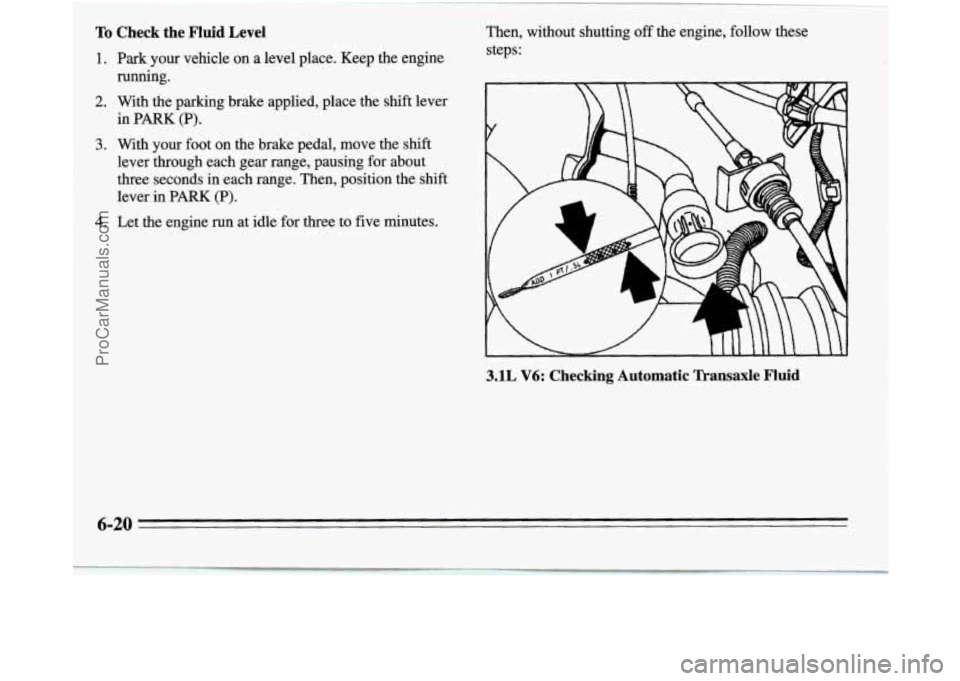
To Check the Fluid Level
1.
2.
3.
4.
Park your vehicle on a level place. Keep the engine
running.
With the parking brake applied, place the shift lever in PARK
(P).
With your foot on the brake pedal, move the shift
lever through each gear range, pausing for about
three seconds in each range. Then, position the shift
lever in PARK (P).
Let the engine run at idle for three to five minutes. Then, without shutting
off the engine, follow these
steps:
3.1L V6: Checking Automatic Transaxle Fluid
6-20
ProCarManuals.com
Page 283 of 390
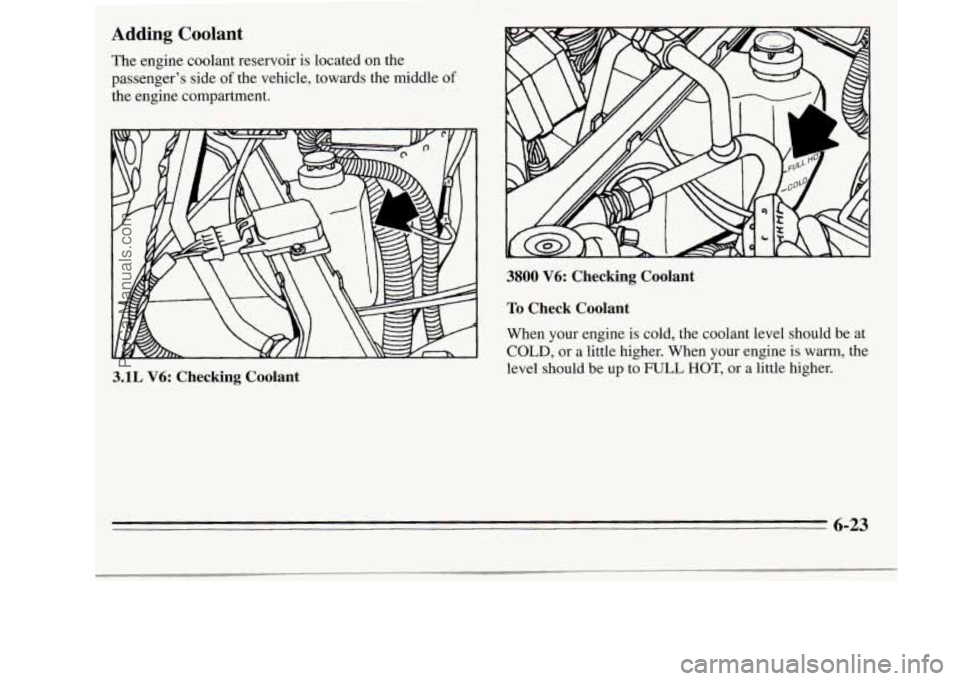
Adding Coolant
The engine coolant reservoir is located on the
passenger’s side
of the vehicle, towards the middle of
the engine compartment.
3.1L V6: Checking Coolant
3800 V6: Checking Coolant
To Check Coolant
When your engine is cold, the coolant level should be at
COLD, or a little higher. When your engine is warm, the
level should be up to
FULL HOT, or a little higher.
6-23
ProCarManuals.com
Page 285 of 390

Power Steering Fluid
3.1L V6: Checking the Power Steering Fluid
The power steering fluid reservoir for the 3.1L V6
engine is located toward the back of the engine
compartment, to the
left of the circular air cleaner.
~~~ ~~~
3800 V6: Checking the Power Steering Fluid
The power steering fluid reservoir for the 3800 V6
engine is located to the right of the engine coolant
reservoir, at the very back
of the engine compartment.
~ 6-25
ProCarManuals.com
Page 286 of 390

How To Check Power Steering Fluid
When the engine compartment is cool, unscrew the cap
and wipe the dipstick with
a clean rag. Replace the cap
and completely tighten
it. Then remove the cap again
and look at the fluid level
on the dipstick.
The level should be at the
FULL COLD mark. Add
enough fluid to bring the level up to the mark.
A fluid loss in this system could indicate a problem.
Have the system inspected and repaired.
What to Add
Refer to the Maintenance Schedule to determine what
kind
of fluid to use. See ‘‘Recommended Fluids and
Lubricants”
in the Index.
Windshield Washer Fluid
To Add
NOTICE:
When adding power steering fluid or making a
complete fluid change, always use the proper
fluid. Failure to use the proper fluid can cause
leaks and damage hoses and seals.
The windshield washer fluid reservoir is located on the
driver’s side of the vehicle, toward the front
of the
engine compartment.
Open the cap labeled
WASHER FLUID ONLY. Add
washer fluid
until the tank is full.
6-26
ProCarManuals.com
Page 311 of 390

Vehicle Identification Number (VIN)
This is the legal identifier for your Oldsmobile. It appears
on a plate in the front corner of the instrument panel, on
the driver’s side. You can see it if you look through
the
windshield from outside your vehicle. The VIN also
appears
on the Vehicle Certification and Service Parts
labels and the certificates of title and registration.
Engine Identification
The eighth character in your VIN is the engine code.
This code will help you identify your engine,
specifications, and replacement parts.
Service Parts Identification Label
You’ll find this label inside the glove box door. It’s very
helpful if you ever need to order parts. On this label is:
your VIN,
the model designation,
0 paint information, and
0 a list of all production options and special equipment.
Be sure that this label is not removed from the vehicle.
Add-on Electrical Equipment
NOTICE:
Don’t add anything electrical to your Oldsmobile
unless you check with your retailer first. Some
electrical equipment can damage your vehicle and
the damage wouldn’t be covered
by your warranty.
Some add-on electrical equipment can keep other
components from working
as they should.
Your vehicle has an air bag system. Before attempting to
add anything electrical to your Oldsmobile, see “Servicing Your
Air Bag-Equipped Oldsmobile” in the Index.
6-51
ProCarManuals.com
Page 326 of 390
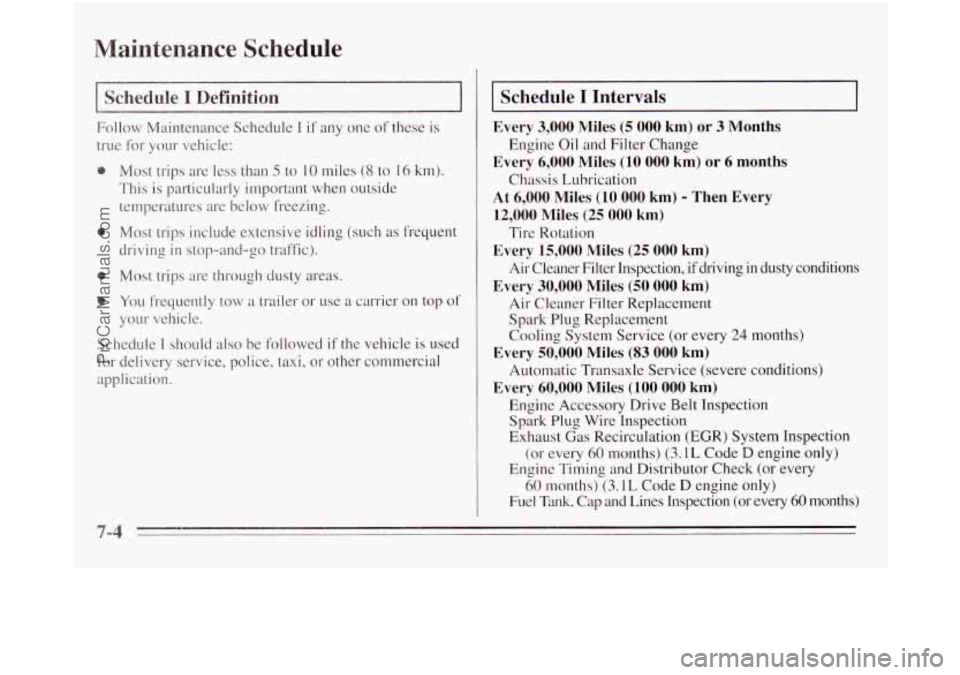
Maintenance Schedule
I Schedule I Definition I
Follow Maintenance Schedule I if any one of these is
true for your vehicle:
0 Most trips are less than 5 to 10 miles (8 to 16 km).
This is particularly important when outside
temperatures are below freezing.
0 Most trips include extensive idling (such as frequent
driving in stop-and-go traffic).
0 Most trips are through dusty areas.
0 You frequently tow a trailer or use a carrier on top 0.f
your vehicle.
Schedule
I should also be followed if the vehicle is used
for delivery service, police, taxi, or other commercial
application.
Schedule I Intervals
Every 3,000 Miles (5 000 km) or 3 Months
Engine Oil and Filter Change
Every 6,000 Miles (10 000 km) or 6 months
Chassis Lubrication
At 6,000 Miles (10 000 km) - Then Every
12,000 Miles (25 000 km)
Tire Rotation
Every 15,000 Miles (25 000 km)
Air Cleaner Filter Inspection, if driving in dusty conditions
Every 30,000 Miles (50 000 km)
Air Cleaner Filter Replacement
Spark Plug Replacement
Cooling System Service (or every
24 months)
Automatic Transaxle Service (severe conditions)
Engine Accessory Drive Belt Inspection
Spark
Plug Wire Inspection
Exhaust
Gas Recirculation (EGR) System Inspection
(or every
60 months) (3.1L Code D engine only)
Engine Timing and Distributor Check (or every
60 months) (3.1 L Code D engine only)
Fuel Tank, Cap and Lines Inspection
(or every 60 months)
Every 50,000 Miles (83 000 km)
Every
60,000 Miles (100 000 km)
7-4
ProCarManuals.com